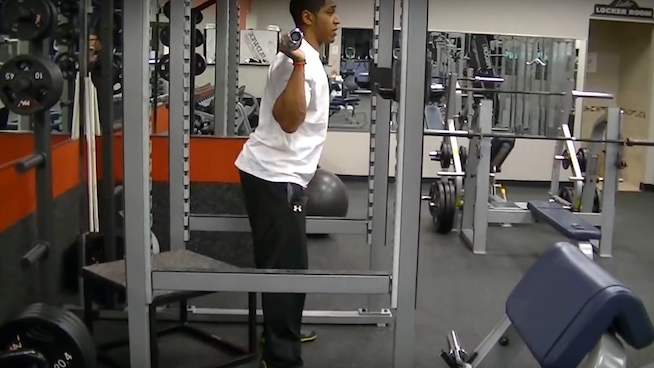Build Max Power with the Box Squat
The Squat is a fundamental exercise that should be included in almost every workout program. If you perform it, I commend you, because it’s not easy. But, I also recommend adding the Box Squat variation to the traditional Squat.
A study that compared the traditional Squat, a powerlifting style Squat (wide stance), and a Box Squat found that the rate of force development for the Box Squat was three to four times greater than that of the other two variations. This is likely due to the pause that occurs on the box before you explosively extend your hips and knees to finish the lift.
This means you produce more force faster, which is critical to your performance on the field. If you can generate force faster, you will jump higher, run faster or add power to nearly any move.
The Box Squat is also great for developing technique. Many of you don’t squat low enough to develop your muscles through their full range of motion. Squatting onto a box fixes this by keeping your depth in check every rep. If your butt doesn’t hit the box, you missed the rep.
When doing this exercise, don’t just squat down to a box. Correctly performing this variation requires a specific technique.
How to Perform the Box Squat
Step 1: Take a shoulder-width or slightly wider stance, depending on your comfort level, with a knee-high box directly behind you. Your setup should be the same as the traditional Back Squat, which you can learn about here.
Step 2: Push your hips back and begin to bend at the knees. Your shins should stay fairly vertical (which also makes this a great exercise to work around injuries).
Step 3: Continue your descent until your butt hits the box. Make sure to keep your core tight when your butt touches the box.
Step 4: To stand up, roll your hips forward, then drive up off of the box. There will be a small rock but don’t rely on momentum to stand up.
For a full demo, check out the video below.
[youtube video=”hdEU-XO3i-0″ /]READ MORE:
- Learn How to Perfect the Front Squat
- Why the Goblet Squat is the Perfect Exercise for Athletes
- The Chain Box Squat is the Best Exercise You’re Not Doing
References:
- Aagaard P. Training induced changes in neural function. Exerc Sports Sci 31: 61-67, 2003.
- Baechle, Thomas R, and Earle, Roger W. NSCA’s Essentials of Strength and Conditioning. Ed 3. Champaign, IL: Human Kinetics, 2008.
- Coburn, Jared, and Malek Moh. “Biomecanics.” NSCA’s Essentials of Personal Training. Ed. 2. Champaign, IL: Human Kinetics,2004. 58.
- Swinton PA, Lloyd R, Keogh JW, Agouris I, and Stewart AD. “A biomechanical comparison of the traditional squat, powerlifting squat, and box squat. J Strength Cond Res 26:1805-1816, 2012.
- Verkhoshanksy, Yuri Vitalievitch, and Mel Cunningham. Supertraining. Rome, Italy: Verkoshanksy, 2009.
RECOMMENDED FOR YOU
MOST POPULAR
Build Max Power with the Box Squat
The Squat is a fundamental exercise that should be included in almost every workout program. If you perform it, I commend you, because it’s not easy. But, I also recommend adding the Box Squat variation to the traditional Squat.
A study that compared the traditional Squat, a powerlifting style Squat (wide stance), and a Box Squat found that the rate of force development for the Box Squat was three to four times greater than that of the other two variations. This is likely due to the pause that occurs on the box before you explosively extend your hips and knees to finish the lift.
This means you produce more force faster, which is critical to your performance on the field. If you can generate force faster, you will jump higher, run faster or add power to nearly any move.
The Box Squat is also great for developing technique. Many of you don’t squat low enough to develop your muscles through their full range of motion. Squatting onto a box fixes this by keeping your depth in check every rep. If your butt doesn’t hit the box, you missed the rep.
When doing this exercise, don’t just squat down to a box. Correctly performing this variation requires a specific technique.
How to Perform the Box Squat
Step 1: Take a shoulder-width or slightly wider stance, depending on your comfort level, with a knee-high box directly behind you. Your setup should be the same as the traditional Back Squat, which you can learn about here.
Step 2: Push your hips back and begin to bend at the knees. Your shins should stay fairly vertical (which also makes this a great exercise to work around injuries).
Step 3: Continue your descent until your butt hits the box. Make sure to keep your core tight when your butt touches the box.
Step 4: To stand up, roll your hips forward, then drive up off of the box. There will be a small rock but don’t rely on momentum to stand up.
For a full demo, check out the video below.
[youtube video=”hdEU-XO3i-0″ /]READ MORE:
- Learn How to Perfect the Front Squat
- Why the Goblet Squat is the Perfect Exercise for Athletes
- The Chain Box Squat is the Best Exercise You’re Not Doing
References:
- Aagaard P. Training induced changes in neural function. Exerc Sports Sci 31: 61-67, 2003.
- Baechle, Thomas R, and Earle, Roger W. NSCA’s Essentials of Strength and Conditioning. Ed 3. Champaign, IL: Human Kinetics, 2008.
- Coburn, Jared, and Malek Moh. “Biomecanics.” NSCA’s Essentials of Personal Training. Ed. 2. Champaign, IL: Human Kinetics,2004. 58.
- Swinton PA, Lloyd R, Keogh JW, Agouris I, and Stewart AD. “A biomechanical comparison of the traditional squat, powerlifting squat, and box squat. J Strength Cond Res 26:1805-1816, 2012.
- Verkhoshanksy, Yuri Vitalievitch, and Mel Cunningham. Supertraining. Rome, Italy: Verkoshanksy, 2009.












